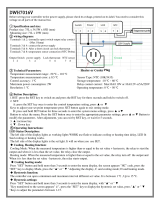
Installation and User Guide DEVIreg™ Multi
FEC | Produced by Danfoss © 3
Table of content
1 Introduction .......................................................................4
2 Safety Instructions .................................................................5
3 Mounting Instructions .............................................................5
4 User Manual .......................................................................6
4.1 Control modes overview ....................................................6
4.2 Terms and abbreviations ....................................................7
4.3 General use .............................................................. 10
4.4 Control modes, special functions, special statuses and settings .............15
4.4.1 Active and Not Active Channel status ..................................... 15
4.4.2 Relay status RO/RC – special setting for status ‘Heating On’ ................. 17
4.4.3 1S or Single Sensor mode and Sensor Type set up ......................... 17
4.4.3.1 1S mode ................................................................. 17
4.4.3.2 Sensor Type set up ....................................................... 20
4.4.4 PR or Power Regulation mode ............................................ 21
4.4.5 MOn and MOf – Manually heating On and Manually heating Of mode ......23
4.4.6 CableOK? – special channel function ...................................... 24
4.4.7 Channel ON/OFF – special function ....................................... 26
4.4.8 Device ON/OFF – special function and switch .............................. 27
4.4.9 Relay Test 5/30– special function .......................................... 29
4.4.10 Alarms, alarm data and alarm relay ........................................ 29
4.4.11 Relay Counters view and reset ............................................ 31
4.4.12 Language setting ......................................................... 32
4.4.13 Date and Time settings ................................................... 32
4.4.14 BMS settings ............................................................. 32
5 Connection diagram ............................................................. 33
6 Technical Specifications .......................................................... 34
6.1 Technical data ............................................................ 34
6.2 Dimensions .............................................................. 35
7 Disposal Instruction .............................................................. 36
Appendix A. BMS and RS-485 interface .............................................37
A1. Communication settings ......................................................37
A2. RS-485 specifications .......................................................... 37
A3. Modbus parameters and variables .............................................37
Warranty ............................................................................ 46




















